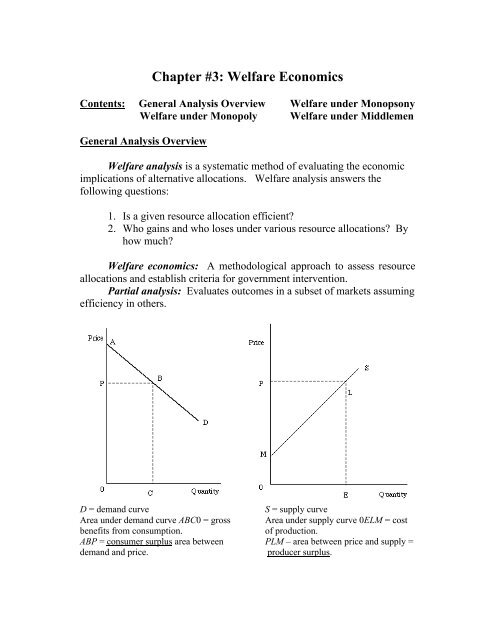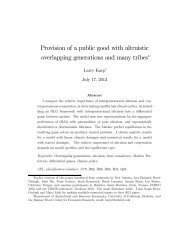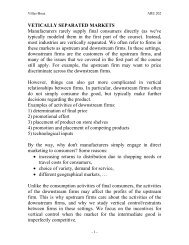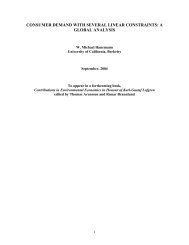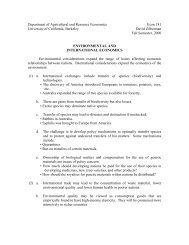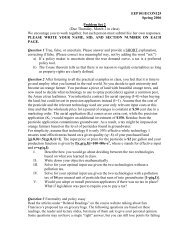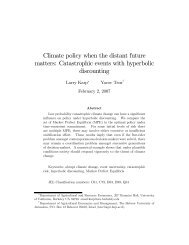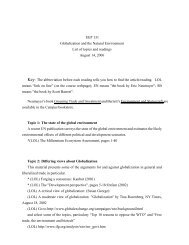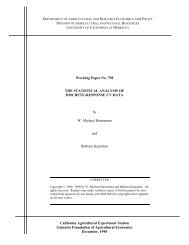Chapter #3: Welfare Economics - Agricultural and Resource ...
Chapter #3: Welfare Economics - Agricultural and Resource ...
Chapter #3: Welfare Economics - Agricultural and Resource ...
Create successful ePaper yourself
Turn your PDF publications into a flip-book with our unique Google optimized e-Paper software.
<strong>Chapter</strong> <strong>#3</strong>: <strong>Welfare</strong> <strong>Economics</strong><br />
Contents: General Analysis Overview <strong>Welfare</strong> under Monopsony<br />
<strong>Welfare</strong> under Monopoly <strong>Welfare</strong> under Middlemen<br />
General Analysis Overview<br />
<strong>Welfare</strong> analysis is a systematic method of evaluating the economic<br />
implications of alternative allocations. <strong>Welfare</strong> analysis answers the<br />
following questions:<br />
1. Is a given resource allocation efficient?<br />
2. Who gains <strong>and</strong> who loses under various resource allocations? By<br />
how much?<br />
<strong>Welfare</strong> economics: A methodological approach to assess resource<br />
allocations <strong>and</strong> establish criteria for government intervention.<br />
Partial analysis: Evaluates outcomes in a subset of markets assuming<br />
efficiency in others.<br />
D = dem<strong>and</strong> curve S = supply curve<br />
Area under dem<strong>and</strong> curve ABC0 = gross Area under supply curve 0ELM = cost<br />
benefits from consumption. of production.<br />
ABP = consumer surplus area between PLM – area between price <strong>and</strong> supply =<br />
dem<strong>and</strong> <strong>and</strong> price. producer surplus.
When there are no externalities, an efficient outcome occurs where the<br />
sum of consumers’ <strong>and</strong> producers’ surplus is maximized.<br />
• Area under dem<strong>and</strong> = gross benefits<br />
• Area under supply = gross cost<br />
• Social surplus = gross benefit – cost.<br />
• A competitive equilibrium is efficient. It maximizes sum of<br />
consumer <strong>and</strong> producers surplus.<br />
2
<strong>Welfare</strong> under Monopoly<br />
A monopoly is the only seller in a market. The basic condition for a<br />
monopoly is below:<br />
Maximizes P(Q) Q − C(Q)<br />
Q<br />
P(Q) = Inverse dem<strong>and</strong>: price as a function of quantity<br />
C(Q) = quantity.<br />
Optimality occurs where:<br />
P + Q ∂P ∂C<br />
− = 0<br />
∂Q ∂Q<br />
MR(Q) − ML(Q) = 0<br />
MR = marginal revenue<br />
MC = marginal cost.<br />
Q C = quantity under competition P M = price under monopoly<br />
P c = price under competition Q M = quantity under monopoly.<br />
A monopoly produces too little <strong>and</strong> charges too much. <strong>Welfare</strong> loss<br />
under monopoly is ΔABC.<br />
3
Linear Example of Monopoly<br />
inverse dem<strong>and</strong> = P(Q) = a - bQ<br />
revenue = (a - bQ)Q = aQ-bQ 2<br />
supply = c + dQ<br />
competitive outcome = a - bQ = c + dQ<br />
Under monopoly,<br />
Q c =<br />
a − c<br />
b + d<br />
P c = a −<br />
P c =<br />
4<br />
ba − bc<br />
b + d<br />
ad + bc<br />
b + d .<br />
a − 2bQ = c + dQ<br />
Q M =<br />
a − c<br />
2b + d
( a − c)<br />
PM = a −<br />
2b + d<br />
= a b + d ( ) + bc<br />
2b + d<br />
dem<strong>and</strong> = 10 − Q<br />
supply = 1+ Q<br />
10 −1<br />
10 +1<br />
QC = = 4.5 PC = = 5.5<br />
2<br />
2<br />
Q M = 9<br />
3 = 3 P M = 7<br />
<strong>Welfare</strong> under Monopsony<br />
A monopsony is the only buyer in a market.<br />
5
Maximize<br />
Q<br />
B(Q) − QMC(Q)<br />
Q<br />
B(Q) = ∫ P(z)dz = area under dem<strong>and</strong>. The optimality condition is:<br />
0<br />
∂B ∂MC<br />
= Q + MC(Q)<br />
∂Q ∂Q<br />
P mn = price paid by monopsonist<br />
Q mn = quantity produced by monopsonist<br />
MC(Q) = marginal cost of producers.<br />
Price paid by monopsony<br />
MO = marginal outlay = MC(Q) + ∂MC<br />
∂Q .<br />
=> Monopsonist: Underbuys <strong>and</strong> underpays.<br />
Monopolist: Underbuys <strong>and</strong> oversells.<br />
6
<strong>Welfare</strong> under Middlemen<br />
A middleman is the only buyer <strong>and</strong> seller of product.<br />
Q MM = middlemen output<br />
S<br />
PMM = price paid by middlemen to suppliers<br />
B<br />
PMM = price paid to middlemen by buyers<br />
B S<br />
PMM CE PMM = middlemen profit<br />
7


